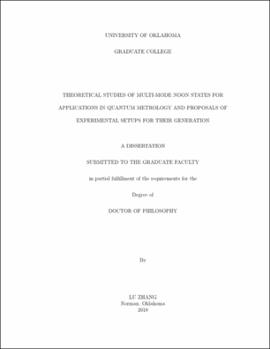| dc.contributor.advisor | Chan, Kam Wai Clifford | |
| dc.contributor.author | Zhang, Lu | |
| dc.date.accessioned | 2018-05-07T18:53:17Z | |
| dc.date.available | 2018-05-07T18:53:17Z | |
| dc.date.issued | 2018-05 | |
| dc.identifier.uri | https://hdl.handle.net/11244/299794 | |
| dc.description.abstract | Quantum entanglement is a fascinating physical resource that is central to the field of quantum information processing with important applications in such areas as quantum computing, quantum communication, quantum metrology, and quantum imaging.
It describes the physical phenomenon in which the quantum state of a multipartite system cannot be written as consisting of constituents that are independent of each other. In this case, the state of the system is called an entangled state. In this
dissertation, the entanglement of photons--the elementary excitations of the quantized electromagnetic field--is studied. A focus is made on a particular type of entangled states of light called the d-mode N-photon NOON state, which consists of N photons with the N photons as an ensemble appearing at d orthogonal modes simultaneously and are inseparable.
In quantum metrology, a field that investigates the ultimate precision of measurements of unknown physical parameters, the two-mode NOON state has been studied extensively with respect to its ability to achieve super-resolution and super-sensitivity in the estimation of a single parameter. A lot of theoretical research has been conducted on the generation of two-mode NOON states, and two-mode NOON states with up to 4 photons have been experimentally and efficiently produced. On the other hand, recently there has been increasing interest in the study of the simultaneous estimation of multiple parameters. Accordingly, the multi-mode NOON state has been attracting more and more attention in view of its potential for enhanced efficiency as compared to using multiple two-mode NOON states separately to estimate the parameters. Nevertheless, no known generation method of multi-mode NOON states with more than 2 photons or 2 modes exists so far.
In this dissertation, several scalable generation methods of multi-mode NOON states are proposed. These methods take advantage of multi-photon quantum interference and they can theoretically be applied to produce NOON states with an
arbitrary number of modes and an arbitrary number of photons. The intrinsic generation probability for each method is calculated, and the methods are compared in regards to their feasibility and efficiency. The advantages of using multi-mode NOON
states in quantum metrology are also analyzed and discussed in detail. | en_US |
| dc.language | en_US | en_US |
| dc.subject | Physics, Optics. | en_US |
| dc.subject | Engineering, Electronics and Electrical. | en_US |
| dc.subject | Physics, General. | en_US |
| dc.title | THEORETICAL STUDIES OF MULTI-MODE NOON STATES FOR APPLICATIONS IN QUANTUM METROLOGY AND PROPOSALS OF EXPERIMENTAL SETUPS FOR THEIR GENERATION | en_US |
| dc.contributor.committeeMember | Marino, Alberto | |
| dc.contributor.committeeMember | Cheng, Samuel | |
| dc.contributor.committeeMember | Huck, Robert | |
| dc.contributor.committeeMember | MacDonald, Gregory | |
| dc.contributor.committeeMember | Verma, Pramode | |
| dc.date.manuscript | 2018-05 | |
| dc.thesis.degree | Ph.D. | en_US |
| ou.group | College of Engineering::School of Electrical and Computer Engineering | en_US |
